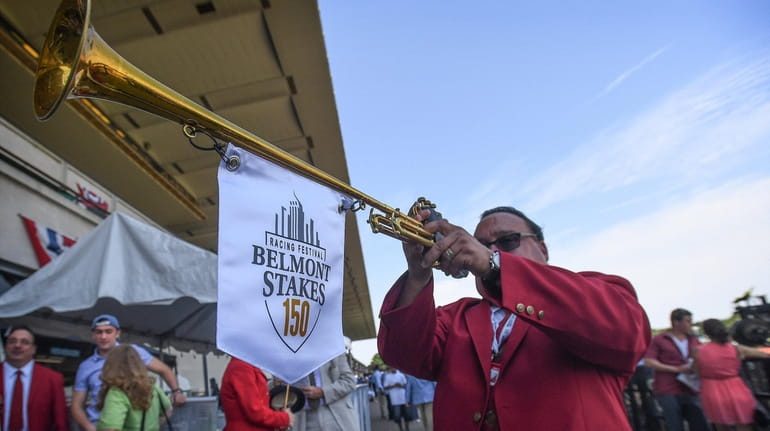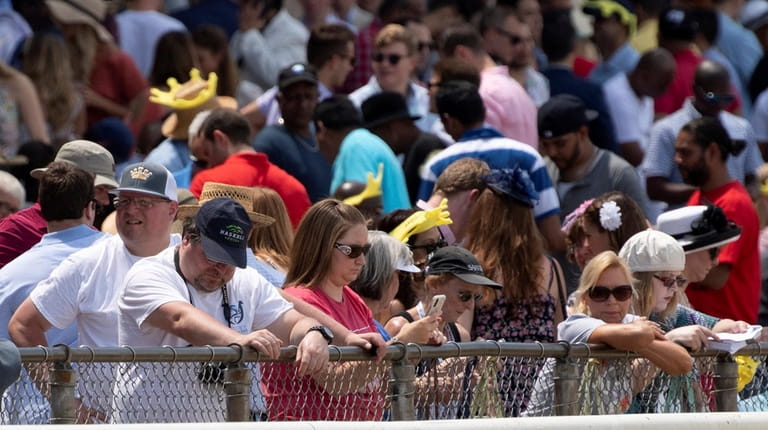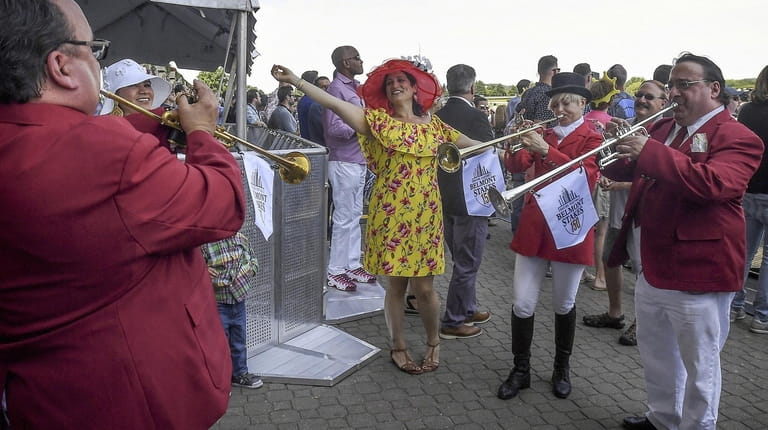Across the board, the Belmont Stakes is always special, and lack of fans won't change that

Sam the Bugler at Belmont Park in Elmont awaiting the start the the 150th running of the Belmont Stakes on June 9, 2018 Credit: Newsday/Thomas A. Ferrara
When it finally was announced that the Belmont Stakes would be run on June 20 without any fans, the news was met with the sort of accepting resignation that has typified sports fandom in the age of pandemic.
The decision is smart, safe and necessary, and when it comes to the sports we consume, most have reached a dutiful understanding: No fans is better than no sports, and it would be really nice to watch something other than a decade-old baseball game on a Saturday afternoon.
But none of that means we can’t acknowledge that, in a pre-COVID-19 world, the Belmont Stakes would have been run Saturday, and that the loss of a true race day experience is yet another entry on the seemingly infinite list of things this virus has stolen, even if it’s deep in the catalog. Maybe even more than that, it’s a stark reminder of all the ways the world has changed, perhaps permanently, and likely to a degree we’ve yet to fully understand.
The Belmont racing season began quietly this past Wednesday, with no spectators. And in late June, the bugler's call to post again will be blown into an empty echo instead of the feverish roar of 90,000 fans. The all-day party will be reduced to its core properties: a handful of races, 13 during a normal year, only one of which the general population really cares about.
It’s usually over in about 2 1/2 minutes, but it’ll take much less time this go around, because it’s the first Triple Crown race this season and the length has been diminished from 1 ½ miles to 1 1/8. They’re still not even sure if the horses' owners will be allowed entry, said Alicia Hughes, a spokeswoman for the National Thoroughbred Racing Association.
If there does end up being a Triple Crown winner, it’ll be one with an asterisk. The races this year are over the course of 15 weeks, not five, and Belmont, that grueling "Test of the Champion," won’t be quite so difficult because of the order of the races and its shorter length. Even the Belmont purse reflects that: The winnings have been cut from $1.5 million to $1 million.
“Of course it’s going to be different,” Hughes said. “All the sports that have come back . . . they’re holding events without fans. That’s going to be our new reality for the foreseeable future, so it’s definitely going to be different from just the atmosphere perspective obviously, but also for our bottom line.”

The crowds gather waiting for the start of fifth race at Belmont Park in Elmont at the 150th running of the Belmont Stakes on Saturday, June 9, 2018. Credit: Dave Lyons
Love or hate the Belmont — and there are plenty of detractors — it’s a quintessential Long Island event and one of the many unofficial starts to summer, up there with ice cream truck jingles and watching the sun go down in Montauk, lobster roll in hand. But unlike those other things, Belmont is all about pomp. There are seersucker suits, summer dresses, and women wearing hats roughly the size of watermelons — all splashed in a mist of champagne.
It lends itself to the delightfully absurd: Rob Gronkowski showing up to see his (dark) horse, Gronkowski, come in second. One year, the Burger King “king” appeared in the owner’s box — a suitably terrifying sight — while another year, celebrity chef Bobby Flay made the rounds. And then there’s the juxtaposition of the dashing clothes and all that mud, all those port-a-potties. It’s a day when everyone who wants to can pretend to be Jay Gatsby, if only for a few hours.
But even without all those things, horse racing is remarkably well-suited to this new world. Those who choose to gamble still can do so, meaning that while the bottom line will suffer, it won’t suffer as much as it would for other sports. Horses don’t care if you’re rooting for them. It’s likely jockeys don’t, either.
“I’ve never heard a jockey say, ‘It was the crowd that really carried me,' ” Hughes said. “They’re so laser-focused, and all they’re hearing is the sound of the hoofs beating around them . . . Horses don’t care if there’s 90,000 people there or nine.”

A woman dances to the buglers at Belmont Park in Elmont as they await the start the the 150th running of the Belmont Stakes on June 9, 2018 Credit: Newsday/Thomas A. Ferrara
And maybe there’s something to mourn in that, too.
Belmont will be so vastly different without fans, but, in many ways, it won’t be different at all. The other sports will come back, too, eventually, and there will be games, and walk-off home runs, and interceptions at the 1-yard line, and probably not one fan cheering in person. And then it’ll be over — either in two minutes or three hours — and we’ll click off our TVs, glad for the familiar distraction, but back to a reality that’s changed beyond recognition.

